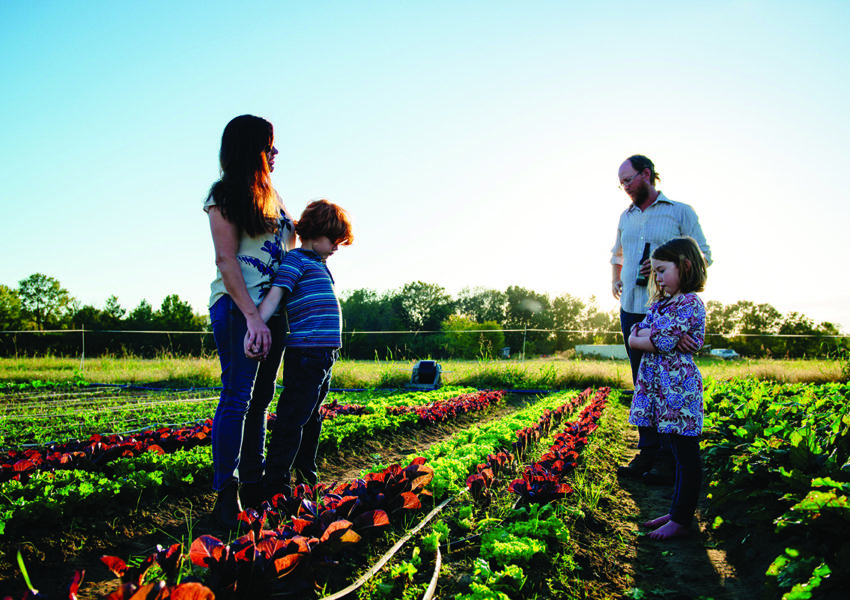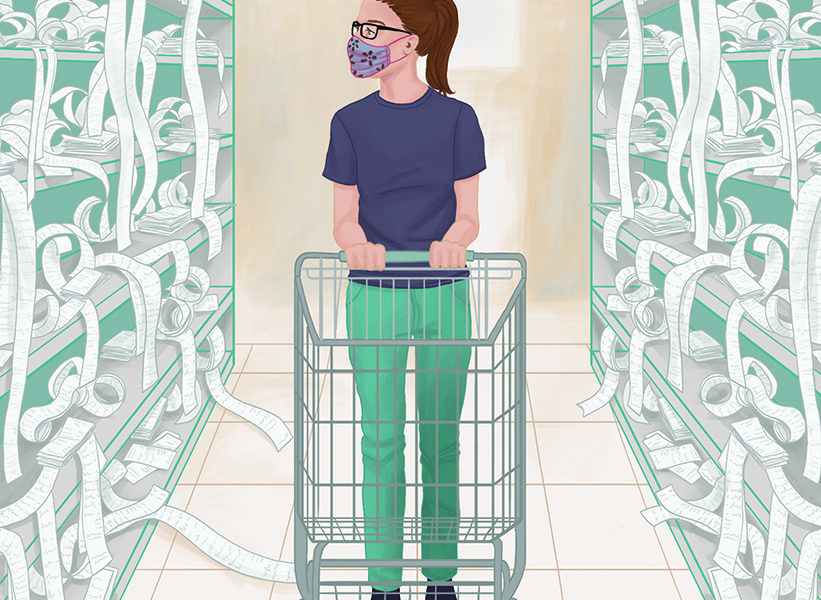Back to the Future Better Fresh is not your grandpa’s farm.
by Alison Miller
photos by Ben Gray
![]()
Grant Anderson stands outside the warehouse in downtown Metter, Georgia, where he runs Better Fresh Farms, tending to catfish filets frying in a cast-iron skillet over a propane flame. It’s the day before Thanksgiving. He and his five employees have completed their deliveries to Savannah and Bluffton, South Carolina, and he’s promised them a homemade lunch and an early end to the day.
Through the open garage doors, past the pickup trucks parked on the concrete floor, five climate-controlled shipping containers act as self-contained farms for the mélange of leafy greens Better Fresh provides to local restaurants, grocers, and residents who stop by or order from the Statesboro Farmers Market.
Inside each windowless 40-by-8-by-9.5–foot cuboid, roots soak in nutrient-rich water and vine-like LED lights deliver a flawless photosynthesis glow. In a town surrounded by 25,000 acres of peanuts, corn, and cotton, this warehouse offers a glimpse into the future of farming. Grant, who grew up in nearby Effingham County, may as well be Marty McFly in work boots.
“Controlled-environment agriculture” is a term you’re bound to hear more as we charge through the twenty-first century. From sprawling glassy greenhouses to forty-foot container farms like Grant’s, indoor growing facilities exponentially increase yield, without pesticides, often in a fraction of the space of row crops. Many of them don’t even need soil. Hydroponic set-ups use as much as 90 percent less water, and they can produce food fifty-two weeks a year, which means consistent employment for workers.
Indoor farms promise year-round food security in the face of climate change, resource scarcity, and increased demand. Well-funded startups have built behemoth greenhouses near New York City, Chicago, and Washington, DC. But they’re also setting up in places where industries like coal and steel once powered the economy. AppHarvest’s flagship greenhouse—irrigated entirely by rainwater—spans a swath the size of forty-five football fields in Morehead, Kentucky. This spring, New York City–based Bowery Farms will start growing baby butter lettuce, arugula, kale, and herbs inside a new facility built on a former Bethlehem Steel brownfield in Pennsylvania’s Lehigh Valley.
Six container farms now comprise Better Fresh Farms in Metter, a blip off I-16 between Macon and Savannah. South Georgia is filled with small communities like this one, where commercial farms produce commodity crops to be shipped across the country and the world. “We’re an ag community that’s isolated from fresh food,” Grant says. He believes container farms can invigorate rural areas while increasing access to local produce, picked at peak flavor and quickly distributed.
Food miles offer a useful, if imperfect, measure of freshness and carbon footprint. By the time a head of romaine arrives in Georgia from California or Arizona, where nearly all the lettuce consumed on the East Coast is grown, it has spent several nights in refrigerated storage and traveled 2,500 miles by truck.
Grant has met some resistance. “I get a lot of comments like, ‘This isn’t how God meant for stuff to be grown,’” he says.
But he’s also heard former Husk Savannah chef Tyler Williams declare his salad the best around (Better Fresh has delivered weekly to Husk since its opening in 2018). He even ships kale to a customer in Maryland, who insists she’s never tasted anything better.

Indoor farms aren’t going to replace commercial row cropping any time soon, if ever. They focus on small plants with short growing cycles—salad greens, herbs, tomatoes, cucumbers, strawberries, and peppers—that net multiple harvests a year. But, Grant has discovered, they may just be the vehicle to bring the South’s agrarian past to the future.
In 2015, Grant, then thirty-one years old and working as a payroll and benefits administrator, was eating lunch at his desk when he clicked on a CNN Business article about Corner Stalk Farm in Boston, a year-round hydroponic farm run by two people with no previous agricultural experience.
Reading the story, he felt a pang for his childhood. He thought of the half-acre plot he tilled and planted alongside his grandparents, who raised him. Noel Conaway loved to yank radishes and pearl onions from the ground, wipe them on his shirt, and pop them into his mouth. And Joann Conaway loved to rib him about it. “Dag gummit, Noel,” she’d say. “You stink!”
Four months later, Grant sat inside the Boston office of Freight Farms, a company that retrofits windowless freight containers—the kind you see cruising down the interstate on eighteen wheels—into farms. He stared at a United States map marked with the number of farms the company had sold in each state. Outside of Florida, the entire Southeast was blank. He combined his savings with a business loan from a local bank, purchased two container farms, and had them delivered to Joann’s backyard in Guyton, Georgia, 300 yards from the half-acre plot he grew up tending.
When Grant’s cousins came to help, Joann joyfully returned to the to the role she’d played when they were young. She made sandwiches and sour cream pound cake and fussed at them if they got too busy to come to the house and eat.
Grant knew he was onto something, but he needed help. The farms he purchased came with the promise of plug-and-play success, but his butter lettuce did not grow at the rate the company advertised. None of the lettuce did. Grant, a Georgia Tech grad, was stumped—and scared.
“To the point of on my knees, in tears, some days because I had so much work ahead of me and I knew even if I got it all accomplished, I still wasn’t going to be able to pay bills that month.”
Joann climbed into the cab of her grandson’s truck and rode with him to church group meetings where she’d arranged for him to speak. She’d set out pineapple sandwiches. He’d explain indoor farming. When a potential investor flew in while Grant was out delivering greens, Joann welcomed him in, proselytized soilless growing, and fixed him a slice of cake.
The investor signed on. Others followed. And then the director of economic development for the city of Metter, fifty miles west, called with a proposal: Would Grant move his farms there and anchor a new, state-funded, ag-tech-business incubator?
“What you’re looking at is a science project,” Grant says, two years after setting up shop in Metter. He extends an arm toward the containers that now fill one corner of the city’s former public works garage, a metal-walled building that used to house vehicle parts, traffic cones, and buckets of hydraulic oil.
“I really thought I was starting a farm business, but we’ve spent a lot more time thinking about where we fit into the food industry,” he says. “We need to figure out how we can compete with the stuff from California.”
Better Fresh Farms turns out eight types of lettuce, plus kale, collards, radishes, basil, Swiss chard, and bok choy. Grant knows that in order to secure funding to place these container farms in critical locations around the state, he needs to garner a reputation. He needs to become the lettuce king of Georgia.
“I’ve always wanted it to be collards, that’s just the Southern boy in me,” he says. “But telling people I have fresh collards in May is like fixing a batch of chili. It just doesn’t seem to fit.”

Which begs the question: What is lost when we engineer season and terroir? Indoor farms mimic the nutrients of soil types. Proponents argue that nutrition and flavor diminish by the hour after harvest, so a shorter path to market should be the goal. Hydroponic farms in the South translate to fewer food miles, less wasted water, and reduced chemical runoff to rivers and lakes. But they also use electricity. “Over time, the goal is a net-zero operation,” Grant says, which he plans to achieve via composting, solar power, and more efficient HVAC and LED systems.
When done right, row cropping with regenerative land practices achieves similar results. But on a practical level, it can be hard for farmers to square the long-term benefits of regenerative agriculture with the short-term demands of the market. “We use as little as we can to let [the plants] do the best they can,” Grant says. “It’s a direct contrast to what traditional farmers are forced to do now to get a marketable product. It’s not to knock them. It’s just where we are.”
Grant walks from container to container, talking pH and nutrient content and recounting front-line tales, like the time he rushed over at 2 a.m. to repair a broken water pump. Then he starts to tell his own story.
“I don’t eat a lot of homemade food anymore,” he reveals. “My wife and I cook when we can, but not like Grandma did.” Every couple of years, Joann makes a somber announcement. Something like, “I’m not making jelly anymore,” or, “This is my last batch of pickles.” The family recipe version of Marty McFly’s fading sibling photograph.

“That really hurt my heart over the years,” Grant says. “A lot of people love her who barely know her because they ate something she cooked and could tell she cared when she cooked it.”
He remembers Joann driving to his high school with a pot of chicken and dumplings to feed the basketball team before their games. The way she flavored and fortified white rice with leftover ham stock. The way she playfully scolded Grandpa Noel about reeking of raw onions and radishes.
Those memories stick with Grant. So do the memories—harder ones—of time he spent in the finance industry. “I was responsible for a foreclosed real estate portfolio in my hometown. And I was responsible for selling property that, in some cases, my family had lost. There was a pit in my stomach. At times, I felt like what I was doing wasn’t right.
“This,” he says, tapping a palm to one of his original container farms, “almost immediately—even though it was different—meant something to me.”
It was a radish that landed Better Fresh an important early client, Emporium Kitchen & Wine Market in Savannah’s posh Perry Lane Hotel. On a Saturday morning in 2018, Grant manned a table of produce at Savannah’s Forsyth Farmers Market. Bags of salad greens piled up next to a basket of D’Avignon radishes, a small French varietal. Andrew Wilson, then the executive chef of Emporium, approached the table. He’d been looking for that exact radish for a simple French breakfast dish he hoped to feature on the opening menu. He bought a bag and, when the restaurant opened, called Grant to lock in weekly deliveries. “It was certainly not the radishes my grandpa grew,” Grant says. And Grant’s not the backyard gardener his grandpa was, triumphantly munching his crop fresh from the dirt. But he is forging a path forward for local agriculture on a small patch of land in Georgia. Different, but the same.
Alison Miller is a freelance writer and editor in Athens, Georgia. She is a 2021 graduate of the Narrative Nonfiction MFA program at the University of Georgia and a part-time instructor at UGA’s Grady College of Journalism and Mass Communication.
SIGN UP FOR THE DIGEST TO RECEIVE GRAVY IN YOUR INBOX.




